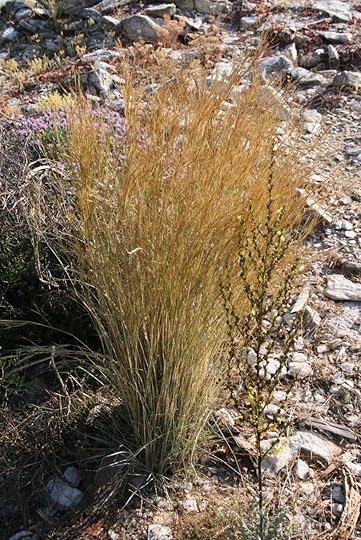Eat Pooideae (A Problem For Hungry Humans)
Pooideae is a subfamily within the biological family of grasses, Poaceae. Grasses within the Pooideae subfamily include wheat, rye, barley, corn, and rice, as well as the rye grass and Kentucky bluegrass in your back yard and wild grasses in fields near your home.
Pooideae grasses can be promiscuous. Some of the grasses in this subfamily are able to cross-fertilize and mate with each other. This is how, for instance, einkorn wheat from 10,000 years ago evolved to create emmer wheat, the 28-chromosome of the Bible. Emmer is the product of the natural mating of 14-chromosome einkorn with a 14-chromosome wild grass, Aegilops speltoides, typically regarded as animal fodder for ruminants or as a weed. Wheat is a grass and it shares genes with other grasses. Eating the seeds of grasses means consuming products from many grasses.

Aegilops speltoides in Greece. Courtesy Wikimedia Commons. Attribution: Sten
I pick on wheat most of all for a variety of reasons:
Wheat is more promiscuous than other grasses. Because of this capacity to multiply its genetic content of chromosomes (“polyploidy”), the genetics of wheat is more complex than most other grasses. It means that there is greater variability from strain to strain, from year to year, within wheat. Because of this variability, it also has a wider range of effects in humans who consume it.
It enjoys such an exalted position in conventional nutritional advice. When we are advised to consume more “healthy whole grains,” rarely are they referring to teff or amaranth; they are referring mostly to wheat.
The manipulations of geneticists and agribusiness of the last 50 years have amplified the deleterious effects of wheat, such as alterations in the amino acid sequence of the gliadin protein that triggers celiac disease, opiate effects on the human brain, and initiates autoimmunity in the intestinal tract.
This does not mean, however, that if a seed of a grass — “grain” — is not wheat it must therefore be good. Other grains are, for the most part, less bad than wheat. Just because the zein protein of corn is less potent in triggering the sequence of events leading to celiac disease does not mean it is not without autoimmune consequences. Just because the wheat germ agglutinin of rice (though still called “wheat germ agglutinin” in rice, since the amino acid sequence is identical) is present in lesser quantities does not mean that it still does not exert adverse intestinal consequences as it does from wheat.
The seeds of Pooideae grasses have always been a problem for hungry humans. At first, they were eaten out of desperation; now they serve as the source of 50% of all calories: from desperation to commoditization.
Here is what Pulitzer prize-winning author, Jared Diamond, PhD, author of Guns, Germs, and Steel, has to say about corn, the human domesticated brethren of teosinte and maize:
“Corn, first domesticated in Central America thousands of years ago, became the basis of intensive farming in those valleys around A.D. 1000. Until then, Indian hunter-gatherers had skeletons ‘so healthy it is somewhat discouraging to work with them,’ as one paleopathologist complained. With the arrival of corn, Indian skeletons sudden became interesting to study. The number of cavities in an average adult’s mouth jumped from fewer than one to nearly seven, and tooth loss and abscesses became rampant. Enamel defects in children’s milk teeth imply that pregnant and nursing mothers were severely undernourished. Anemia quadrupled in frequency; tuberculosis became established as an epidemic disease; half the population suffered from yaws or syphilis; and two-thirds suffered from osteoarthritis and other degenerative disease. Mortality rates at every age increased, with the result that only 1 percent of the population survived past age fifty, as compared to 5 percent in the golden days before corn. Almost one-fifth of the whole population died between the ages of one an four, probably because weaned toddlers succumbed to malnutrition and infectious diseases. Thus corn, usually considered among the New World’s blessings, actually proved to be a public-health disaster.”
Jared Diamond, PhD
The Third Chimpanzee
All grains are unhealthy for humans. It’s all a matter of degree.
The post Eat Pooideae (A Problem For Hungry Humans) appeared first on Dr. William Davis.
Dr. Davis Infinite Health Blog
Recognize that this i The insights and strategies you can learn about in Dr. Davis' Infinite Health Blog are those that you can put to work to regain magnificent health, slenderness, and youthfulness.
Recognize that this is NOT what your doctor or the healthcare system provides, as they are mostly interested in dispensing pharmaceuticals and procedures to generate revenues. The healthcare INDUSTRY is not concerned with health--you must therefore take the reins yourself.
Dr. Davis focuses on:
--Real, powerful nutritional strategies
--Addresing nutrient deficiencies unique to modern lifestyles
--Deep insights into rebuilding the microbiome disrupted by so many modern factors
Follow Dr. Davis here and on social media and you can witness the extraordinary successes people enjoy on his programs. ...more
- William Davis's profile
- 159 followers



